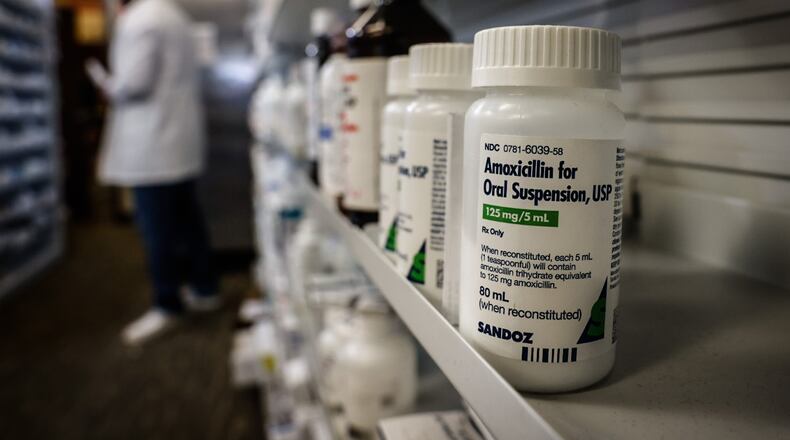Amoxicillin is a common antibiotic used to treat childhood illnesses like ear infections and pneumonia. The U.S. Food and Drug Administration reported a shortage of the liquid version of the drug last month due to increased demand, and the shortage primarily affects pediatric patients.
There are alternative medicines, but pharmacists are also seeing those supplies decrease. There is only one licensed maker of amoxicillin in the U.S., Brown said. The majority of generic drugs and pharmaceutical ingredients are made outside of the U.S. Approximately 28% of manufacturers of active pharmaceutical ingredients are in the U.S., according to the FDA. Other sources include 26% in Europe, 18% in India, 13% in China, 2% in Canada, and the remaining in other parts of the world.
Chad Meyers, a pharmacist and the director of Ambulatory Pharmacy Services at Dayton Children’s Hospital, said they began hearing from patients’ families about the difficulty they had in finding amoxicillin approximately two months ago. When alternatives started drying up this month, their pharmacy turned to making compounded versions of those products from FDA-approved tablets and capsules for their pediatric patients who cannot ingest tablets or capsules, which is not something all pharmacies have the capability to do, Meyers said.
“The shortage of amoxicillin is an ongoing challenge for community pharmacies and families with young children,” said Meyers. “We’ve had families drive almost an hour because the Dayton Children’s pharmacy was the only one that had amoxicillin available for their child. We are grateful we have the capability to go above and beyond in making sure we have viable antibiotic treatment options available for all children within our reach.”
Increased wait and drive times, reduced curbside services at pharmacy locations, and increased man hours at pharmacies have all been challenges to come from the amoxicillin shortage.
Dr. Kevin Turner, who is a pediatrician with University Hospitals Rainbow Babies and Children’s and the senior medical director at Rainbow Primary Care Institute at University Hospitals in Cleveland, said using alternatives can also lead to delays and potential errors. The increased work between doctors and pharmacists to find available medications is also bogging down a system that is already seeing increased illnesses, he said.
While amoxicillin is not used to treat the ongoing surge of RSV and increasing influenza cases, those illnesses are leading to increased infections.
“That’s leading to increases in our antibiotic prescriptions,” Turner said. Amoxicillin is the most commonly prescribed antibiotic in general, particularly for pediatric patients, he said.
Joy Duaka, a pharmacist at Ziks Pharmacy on East Third Street, said his store on Wednesday only had three bottles of liquid amoxicillin left in the store due to the nationwide shortage.
While the FDA has reported fewer drug shortages, Meyers said the shortages that are happening are the medications patients use the most.
Brown and other senators, including Amy Klobuchar (D-MN), Bill Cassidy (R-LA), and Edward Markey (D-MA), sent a letter to Secretary of Health and Human Services Xavier Becerra and FDA Commissioner Robert Califf, asking both agencies to start a drug shortage task force to address the shortage.
“We write to express our strong concern regarding the shortage of amoxicillin and the serious threat that this and other medical shortages pose to our nation’s patients and public health,” the senators said. “The record high levels of respiratory illnesses have spiked demand for amoxicillin and other essential medicines, and patients and providers continue to experience disruptive shortages, which have led to delays in care and compromised health outcomes.”
Brown also discussed his bill, Promoting Readiness and Ensuring Proper Active Pharmaceutical Ingredient Reserves of Essential Medicines (PREPARE) Act of 2021. The PREPARE Act, or Senate Bill 2740, would create an emergency supply of key ingredients used in essential generic medicines and incentivize domestic manufacturing of these ingredients to build a more resilient domestic supply chain.
About the Author

